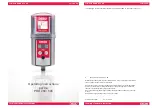
Service and Repair Manual
November 2016
Manifolds
68
GS-2669 DC • GS-3369 DC • GS-4069 DC
Part No. 1272220GT
6-4 Valve Coils
6-4
Valve Coils
How to Test a Coil
A properly functioning coil provides an
electromagnetic force which operates the solenoid
valve. Critical to normal operation is continuity
within the coil. Zero resistance or infinite resistance
indicates the coil has failed.
Since coil resistance is sensitive to temperature,
resistance values outside specification can
produce erratic operation. When coil resistance
decreases below specification, amperage
increases. As resistance rises above specification,
voltage increases.
While valves may operate when coil resistance is
outside specification, maintaining coils within
specification will help ensure proper valve function
over a wide range of operating temperatures.
Electrocution/burn hazard.
Contact with electrically charged
circuits could result in death or
serious injury. Remove all rings,
watches and other jewelry.
Note: If the machine has been in operation, allow
the coil to cool at least 3 hours before performing
this test.
1
Tag and disconnect the wiring from the coil to
be tested.
2
Test the coil resistance using a multimeter set
to resistance (
Ω). Refer to the Valve Coil
Resistance Specification table.
Result: If the resistance is not within the
adjusted specification, plus or minus 10%,
replace the coil.
Valve Coil Resistance
Specification
Note: The following coil resistance specifications
are at an ambient temperature of 68°F / 20°C. As
valve coil resistance is sensitive to changes in air
temperature, the coil resistance will typically
increase or decrease by 4% for each 18°F / 20°C
that your air temperature increases or decreases
from 68°F / 20°C.
Description
Specification
Solenoid valve, 2 position 2 way
24V DC with diode
(schematic items CA, CB, CC, CD, CE,
CF)
25
Ω
Solenoid valve, 2 position 3 way
24V DC with diode
(schematic items BA, FB, FF, FO, FP,
FR, )
35
Ω
Solenoid valve, 3 position 5 way
24V DC with diode (schematic item FL)
35
Ω
















































